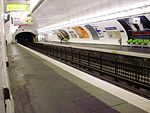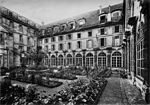Théâtre du Vieux-Colombier
Buildings and structures in the 6th arrondissement of ParisEuropean theatre (structure) stubsFrench building and structure stubsFrench theatre stubsTheatres in Paris

The Théâtre du Vieux-Colombier is a theatre located at 21, rue du Vieux-Colombier, in the 6th arrondissement of Paris. It was founded in 1913 by the theatre producer and playwright Jacques Copeau. Today it is one of the three theatres in Paris used by the Comédie-Française. In May 1944 it saw the première of Jean-Paul Sartre's existentialist drama Huis Clos.
Excerpt from the Wikipedia article Théâtre du Vieux-Colombier (License: CC BY-SA 3.0, Authors, Images).Théâtre du Vieux-Colombier
Rue du Vieux Colombier, Paris 6th Arrondissement (Paris)
Geographical coordinates (GPS) Address Phone number Website External links Nearby Places Show on map
Geographical coordinates (GPS)
| Latitude | Longitude |
|---|---|
| N 48.851797222222 ° | E 2.3302944444444 ° |
Address
Théâtre du Vieux-Colombier
Rue du Vieux Colombier 21
75006 Paris, 6th Arrondissement (Paris)
Ile-de-France, France
Open on Google Maps









